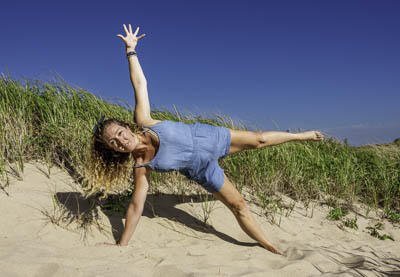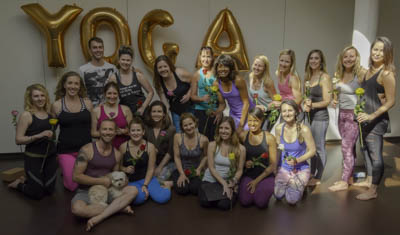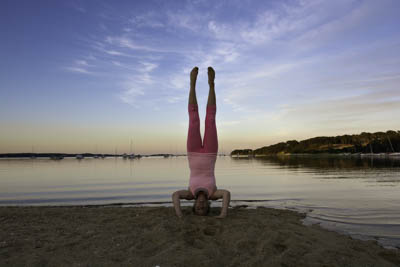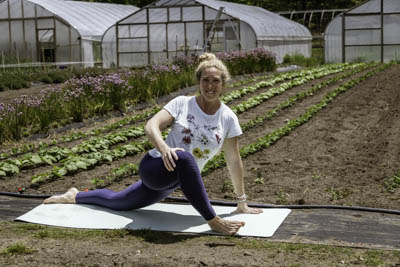Yoga Teaching Style
In today’s fast-paced world, where stress and anxiety have become commonplace, finding solace, and achieving inner peace is more important than ever. Many individuals are seeking ways to enhance their overall well-being and strike a balance between their physical and mental health. For me, yoga has emerged as a powerful tool to achieve just that.
 Like many others, I also discovered yoga to find solace and decompress from the stress of my job. Through my years of practicing and teaching yoga, I have understood that it offers far more than stress relief. It is a powerful tool for building strength, healing physical pain, and fostering a deeper connection with oneself and the community.
Like many others, I also discovered yoga to find solace and decompress from the stress of my job. Through my years of practicing and teaching yoga, I have understood that it offers far more than stress relief. It is a powerful tool for building strength, healing physical pain, and fostering a deeper connection with oneself and the community.
Yoga provides a holistic approach to well-being, addressing our lives physical, mental, and emotional aspects. As we engage in yoga postures, we build strength and flexibility, not only in our physical bodies but also in our minds. The practice challenges us to explore our limits, step out of our comfort zones, and cultivate resilience. Through consistent practice, we gradually witness our own growth and transformation, both on and off the mat.
Additionally, yoga can be a source of healing for physical pain or discomfort. We learn to listen to our bodies and honor their needs by focusing on proper alignment and mindful movement. Yoga can help alleviate tension, improve posture, and increase body awareness. It offers a gentle yet practical approach to addressing physical imbalances and promoting well-being.
Beyond the physical benefits, yoga can deepen our connection with ourselves. We develop a heightened sense of self-awareness and inner peace through breath awareness, meditation, and self-reflection. We learn to observe our thoughts and emotions without judgment, cultivating a compassionate and non-reactive mindset. This deepening connection with ourselves empowers us to navigate life's challenges more clearly, resilient, and gracefully.
Furthermore, yoga has the potential to create a sense of community and connection with others. In a yoga class, practitioners come together with a shared intention and create a supportive environment. The collective energy and presence of fellow practitioners can be inspiring and uplifting. Yoga studios often serve as hubs where individuals from diverse backgrounds come together to cultivate a sense of belonging and support each other's journeys.
A to guide my students
As a yoga teacher, I aim to guide my students through this holistic journey, providing a safe and nurturing space for exploration, growth, and self-discovery. My Training
My Training
I have completed a 200-hour training course certified by the yoga alliance. Since completing the certification in 2014, I have enjoyed teaching various yoga styles. My foundation of training is in the Iyengar yoga lineage from B.K.S Iyengar. This style of yoga is foundational in body alignment, which I then create into a gentle flow. A slow flow can be a potent form of practice that I guide students through. I can also transform the same basic poses into a gentle flow for a therapeutic experience.
The Iyengar style of yoga emphasizes precise body alignment and the use of props to support practitioners in achieving proper posture and alignment. I incorporate these principles into my teaching to ensure students develop a solid foundation in their practice. By focusing on body alignment, I aim to help students improve their posture, strength, and flexibility while reducing the risk of injuries.
However, I also understand the importance of creating a fluid and gentle flow in a yoga class. A slow and deliberate flow can be a powerful way to connect the body, mind, and breath. Therefore, I guide my students through sequences that encourage a seamless transition from one pose to another, maintaining a steady and mindful pace. This approach allows students to cultivate awareness and a deeper connection with their bodies.
Furthermore, I utilize my knowledge of Iyengar yoga to transform the foundational poses into a gentle flow for a therapeutic experience. By adapting the basic postures to suit individual needs and limitations, I aim to create a safe and supportive environment where students can explore their practice at their own pace. This approach makes yoga accessible to many individuals, including those with physical limitations or injuries.
My teaching style combines Iyengar yoga's precision and alignment principles with a gentle flow approach. I prioritize body awareness, proper alignment, and a therapeutic experience for my students, helping them develop strength, flexibility, and overall well-being on and off the mat.
The alignment-based practice can then translate into flow yoga, also known as Vinyasa yoga, is a captivating and transformative form of yoga that seamlessly integrates breath and movement. Unlike traditional yoga practices that focus on holding static poses, flow yoga encourages practitioners to transition fluidly from one pose to another, synchronizing their movements with their breath. This dynamic nature of flow yoga not only builds strength and flexibility but also cultivates mindfulness and awareness.
The Benefits of Flow Yoga: Nurturing Body, Mind, and Spirit
Flow yoga offers a multitude of benefits that extend beyond the physical realm. By incorporating breath awareness and conscious movement, this practice provides a holistic approach to self-care and personal growth. Let’s explore some of the remarkable advantages of flow yoga:
- Strength and Flexibility: Flow yoga sequences are designed to target various muscle groups, enhancing strength and flexibility. Through continuous movement, practitioners develop lean muscle tone and improve joint mobility, fostering a balanced and resilient body.
- Stress Reduction: The flowing nature of this practice promotes relaxation and relieves stress. As you synchronize your breath with movement, the mind becomes more focused, leading to a state of tranquility and calmness. Flow yoga serves as a valuable tool for managing daily stressors and finding inner peace.
- Mind-Body Connection: Flow yoga emphasizes the integration of body and mind, fostering a deep sense of self-awareness. By staying present in each breath and movement, practitioners cultivate mindfulness and develop a heightened connection with their physical and emotional well-being.
- Cardiovascular Health: The dynamic nature of flow yoga elevates the heart rate, making it an excellent cardiovascular workout. Regular practice can improve blood circulation, enhance lung capacity, and boost overall cardiovascular health.
- Improved Focus and Concentration: Flow yoga requires a keen focus on breath and movement, training the mind to be present and attentive. This enhanced mental clarity carries over into daily life, improving focus, concentration, and productivity.
- Emotional Balance: Flow yoga encourages self-reflection and introspection, allowing individuals toexplore their emotions and release any negative energy or tension held within. This emotional release promotes a greater sense of balance and well-being.
Embark on Your Flow Yoga Journey
Are you ready to embark on a transformative journey of self-discovery and physical well-being? Flow yoga offers a path to unlock your inner strength and embrace the mind-body connection. Whether you’re a beginner or an experienced practitioner, the following tips will help you get started:
- Find a Qualified Instructor: Look for a certified flow yoga instructor who resonates with your goals and values. A knowledgeable and experienced teacher can guide you through the practice safely and help you refine your technique.
- Create a Sacred Space: Dedicate a quiet and clutter-free area in your home where you can practice undisturbed. Enhance the ambiance with soft lighting, calming music, and any other elements that inspire tranquility.
- Invest in a Quality Mat: A comfortable and non-slip yoga mat is essential for a seamless flow yoga practice. Choose a mat that provides adequate cushioning.
- Begin with Gentle Movements: Start your flow yoga practice with gentle movements to warm up the body and connect with your breath. Incorporate gentle stretches, joint rotations, and mindful breathing exercises to prepare your body and mind for the flowing sequences ahead.
- Explore Progressive Sequences: As you progress in your practice, gradually introduce more challenging flowing sequences. These sequences may include standing poses, balances, inversions, and peak poses. Embrace the sense of fluid motion and focus on maintaining the connection between your breath and movement.
- Listen to Your Body: Flow yoga is a practice of self-awareness and self-care. Listen to your body and honor its limitations. If a pose feels uncomfortable or causes pain, modify or skip it. Allow yourself to rest when needed and always prioritize safety and alignment in your practice.
- Embrace Stillness and Deep Stretches: After the dynamic sequences, transition into slower, deeper stretches and floor-based asanas. These postures allow your body to cool down, release tension, and promote relaxation. Embrace the opportunity to find stillness, connect with your breath, and savor the benefits of your practice.
It's important to approach yoga with patience and self-compassion, understanding that progress comes with time and consistent effort. Each person's journey is unique, and comparison to others is unnecessary. Embrace your own path and honor your individual progress.
Enjoying each moment along the way is a beautiful perspective to hold. Yoga is not only about achieving specific poses or reaching certain goals; it's about being fully present in the present moment and finding joy in the process. Each practice, even the challenging ones, offers an opportunity for growth, self-discovery, and self-acceptance. Embracing the journey, with all its ups and downs, allows us to cultivate a deeper understanding of ourselves and our bodies.
Self-kindness is crucial on the yoga journey. Remember to listen to your body, respect its limitations, and practice within your comfort zone. Yoga is not about pushing yourself to the point of strain or pain but rather finding the balance between effort and surrender. Celebrate your progress, no matter how small, and acknowledge that even working through difficult moments is a sign of growth and resilience.
Indeed, growth is an integral part of life and a fundamental aspect of the yoga practice. It is through growth that we expand our physical abilities, deepen our self-awareness, and cultivate a greater sense of connection with ourselves and the world around us. Embrace the transformative power of yoga and trust in the process. Remember that growth is not always linear, and setbacks or challenges are opportunities for valuable learning and personal development.
So, as you embark on your yoga journey, may you be kind to yourself, celebrate every step, and find joy in each moment, even during the challenging times. Embrace the process, respect your own unique path, and allow yourself to grow and evolve. Yoga has the potential to be a beautiful and transformative practice, offering profound benefits for your body, mind, and spirit.